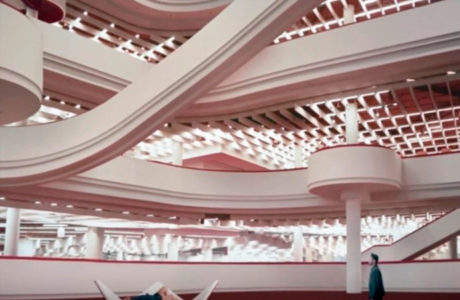The Moment's Innovation Designers look at the practice of service design, and where it will be moving next.
We are strongly rooted in the belief that people matter. As Innovation Designers, we help organizations, communities, and systems thrive by supporting teams and organizations through the transition from where they are now to where they need to be tomorrow. As part of bringing innovation to our clients and our communities, we rely on several different methodologies to embrace new and persistent challenges.
Service design is one such methodology we often call upon to help create and shape organizations and products that work better for people. Whether you’re working in the practice of service design daily, or you have a cursory understanding of the space, one thing is true: organizations of all shapes and sizes are increasingly competing on the basis of experience. Furthermore, new and complex challenges are continuing to emerge that will require systems-level thinking to tackle widespread and deeply embedded issues.
June 1 is known internationally as “Service Design Day”, so we thought this was an opportune moment to take a look at the importance of the practice of service design, and where the practice will be moving next.
Read on to find out what the future of service design has in store directly from the Innovation Designers at The Moment who work in and around service design every day.
Chenny Xia
Individuals tend to think and talk about the lived experiences of services they have personally encountered in the past. As service designers, we can — and should — facilitate the evolution of current service experiences while continuing to look forward. The practice of service design will move to meet the mature expectations of excellence that users and economies already have through the practice’s inherently collaborative and iterative process.
Simon Mhanna
Service design is all about putting people at the heart of the experience and taking a holistic approach to problem solving and co-creating the future. Disruption is quickly changing our current landscape, just look at the proliferation of technologies, the exponential growth of AI, the shifts in global economies, and the future of work, among others. There are great opportunities for service design to take on challenges beyond redesigning mere services and products — we can help to redesign whole communities and systems.
Orchestrating experiences at scale and working alongside data scientists, technologists, economists, storytellers, and public servants in addition to designers and businesses, service designers have the necessary skills and toolkit to tackle juicy problems of the future. Together, the future of service design can co-create and design for challenges such as algorithm biases, AI ethics, climate change, privacy and security, and maybe even life in space. Service design is a key enabler to humanize the world and to create a better future for all of us.
Julie Sommerfreund
I think the natural evolution of service design is moving beyond experiences that delight customers, to creating services that address fundamental challenges people are facing in their daily lives. In order to make that type of impact, the practice of service design will naturally continue its evolution towards incorporating systems thinking and systemic design.
If we look at the public sector as an example, and health care in particular, it is increasingly considering and participating in the service design evolution. This presents an interesting opportunity to reimagine complex public services and policies through a set of tools that help government deliver on society’s interconnected problems. While these problems aren’t new, they are becoming more persistent and complex over time — and service design is an ideal toolset that can be leveraged to help address these many challenges.
As the world continues to become more interconnected and multiple organizations begin to view the full experience of a person’s day-to-day, the opportunities for interesting partnerships and designing ecosystems of services will proliferate, and the need for service design will become increasingly important across society and in our most vulnerable public sector entities.
Karen Oikonen
Service design has the potential to tackle complex human experiences that are individual yet universal. It has the unique ability to weigh into aspects of life where people feel their most vulnerable and provides a framework for understanding the ecosystems that those experiences are embedded within.
Service design as a practice is willing to go deep into our most tender moments as human beings. In this context, I’ve spent a lot of time researching the family experience of death and dying, and how to make that experience better for people. At the end of the day, dying is a human experience, not a clinical experience. Service design has been useful in understanding what is most important to people by putting them at the centre while allowing for a holistic and co-creative approach that is actionable.
As a service designer and researcher, I believe the future of service design includes exploring all aspects of the human condition to design systems and services that better support us all — and that includes end of life.
Heather Daam Rossi
Often people confuse the ‘parts’ of service design with the ‘whole.’ I get that. It’s more than blueprinting! It’s more than customer journey maps! We do need to take the focus off these specific methods in order to reflect on the entire practice and how it might evolve in the future. There’s lots of talk about service design being a big, grand interconnected saviour. AND I AGREE!! But I also think there’s room within service design to push forward the ‘parts’.
What I’m interested in is the process, and the ways in which we work while using these tools and methods. Therefore, when I think about the future of service design, I’m asking myself “how will we work together” and “what role will co-creation play, how we involve people in the process of the future” and what I’m most excited about is “what tools and methods might emerge as the practice grows?” Will we find other “sister field relationships” like we have with social sciences to inspire us, and continue to grow the practice?
My prediction for service design is that service designers will become stronger advocates for the practice. We won’t sit back and let the ‘parts’ that make up service design become the primary focus; we’ll reflect on the whole, and ask ourselves, what’s the blueprint of the future?
Greg Judelman
As service designers, a core focus of our practice is to understand and meet the needs of both the business and end users. In practice, however, these needs frequently come into conflict with one another. Business leaders are often driven by quick wins and are more comfortable with incremental investments. But bringing strategic goals to life requires longer term investments and navigating an iterative process rich with ambiguity.
In the next few years as our practice matures, service designers will get better at navigating this tension between the business (viability) and the user (desirability.) We’ll show value back to the business earlier and more often, and integrate our process more intrinsically with business and technology stakeholders. This subtle yet powerful shift will drive more impact and value downstream to the business and its people – including customers.
_________
At The Moment, we view service design as one capability within twelve that make up the skillset of an innovation designer. To learn more about service design, and the other skills that are leveraged within the practice of Innovation Design, check out our Innovation Designer Capability Map.














